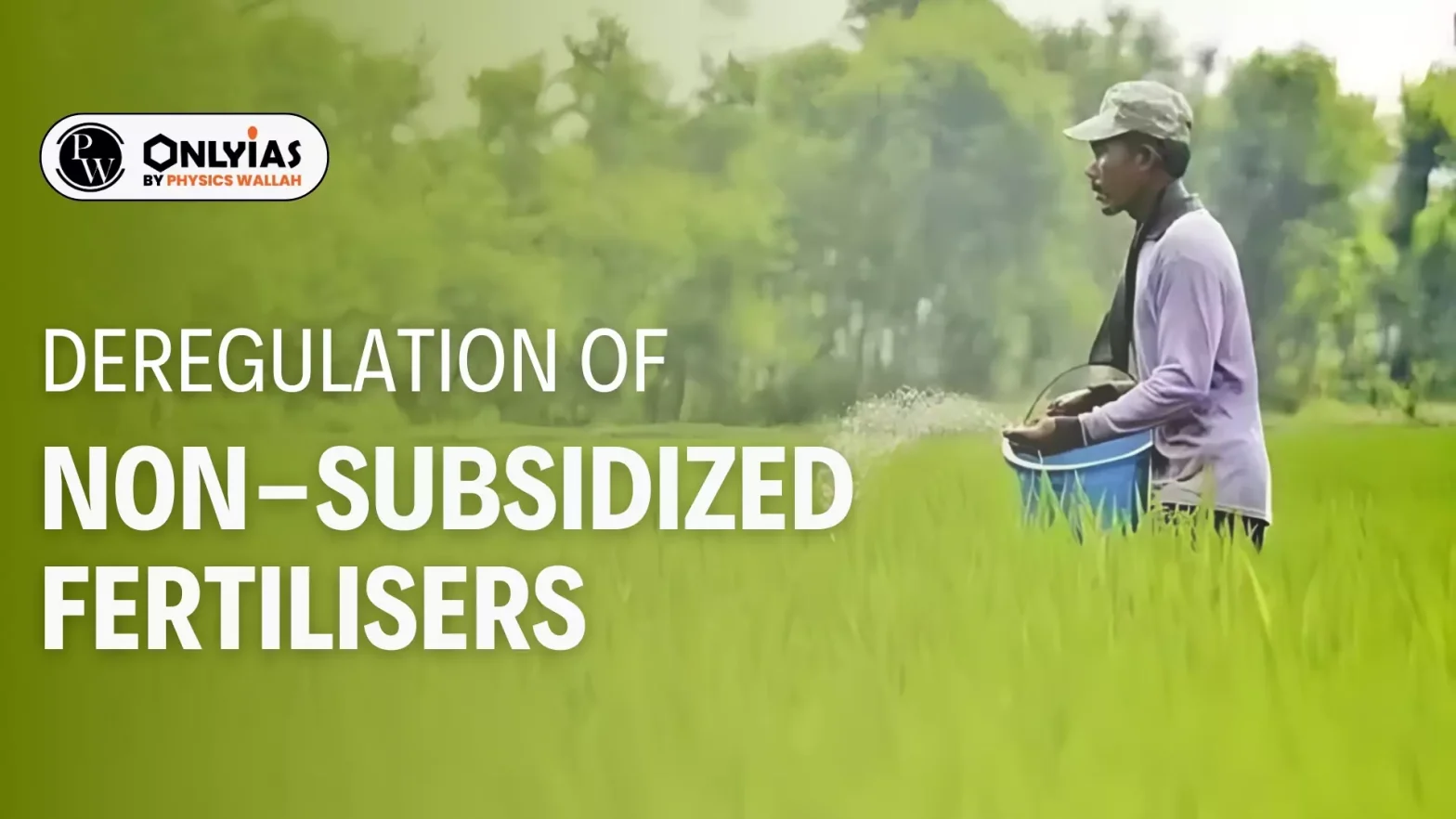With an unconducive environment for price decontrol of urea, DAP and other politically-sensitive nutrients, the focus may now be on expanding the market for non-subsidised fertiliser products through easing of registration requirements
| Relevancy for Prelims: Maximum Retail Price (MRP), Nutrient Based Subsidy (NBS) Scheme, etc.
Relevancy for Mains: Potential benefits and drawbacks of deregulation of non-subsidised fertilizers, etc. |
About Fertiliser Subsidy
- The government pays a subsidy to fertiliser producers to allow farmers to buy fertilisers at below- market rates.
- The difference between the cost of production/import of a fertiliser and the actual amount paid by farmers is the subsidy portion borne by the government.
Enroll now for UPSC Online Course
Subsidy on Urea
- In India, urea is the most produced, imported, consumed and physically regulated fertiliser of all. It is subsidised only for agricultural uses.
- The Centre pays a subsidy on urea to fertiliser manufacturers on the basis of cost of production at each plant and the units are required to sell the fertiliser at the government-set Maximum Retail Price (MRP).
- The MRP of urea is currently fixed at Rs 5,628 per tonne.
Subsidy on Non-Urea Fertilisers
- The MRPs of non-urea fertilisers are decontrolled or fixed by the companies.
- But the government has, in recent times, and especially with the global price surge post the Russia-Ukraine war, brought these fertilisers under the control regime.
- All Non-Urea based fertilisers are regulated under Nutrient Based Subsidy (NBS) Scheme.
- Examples of non-urea fertilisers – DAP and MOP.
- Companies do not sell DAP at more than Rs 27,000 per tonne.
About Non-Subsidized Fertilisers
- Non-subsidized fertilisers are sold at market prices without any government financial assistance or subsidy.
- Farmers purchasing non-subsidized fertilisers pay the full market rate without discounted prices provided by the government.
- The cost of non-subsidized fertilisers can vary based on market conditions, including supply, demand, and international pricing trends.
- Governments often subsidise fertilisers to make them more affordable for farmers, aiming to support agricultural productivity and food security.
- Deregulating non-subsidized fertilisers: It refers to removing government controls or regulations that affect the pricing, distribution, or sale of fertilisers without subsidies.
- Key points about deregulating non-subsidized fertilisers:
- Market-driven pricing: Without government intervention, prices of non-subsidized fertilizers are determined by market forces such as supply, demand, and competition.
- Increased competition: Deregulation can lead to a more competitive market as companies may freely enter the market to offer fertilizers, potentially driving down prices.
- Reduced government expenditure: Governments can save on subsidy costs associated with fertilizers, which may be redirected to other agricultural or developmental initiatives.
- Impact on farmers: Farmers may experience fluctuations in fertilizer prices depending on market conditions, impacting their cost of production and profitability.
- Potential benefits: Deregulation can encourage innovation in fertilizer technologies and distribution methods, potentially improving efficiency and availability.
Why Deregulate Non-Subsidised Fertilizers in India?
- Subsidy Burden:
- The Government of India spends a significant amount on fertilizer subsidies (₹ 163,999.80 crore budgeted for 2024-25).
- However, the subsidy burden is decreasing due to falling global fertilizer prices.
- Slow Registration Process for New Fertilizers:
- Registering a new fertilizer product in India is a slow process, taking an average of 804 days.
- This is significantly longer compared to other countries (e.g., 30 days in the European Union).
- The lengthy process hinders the introduction of innovative fertilizers for Indian farmers.
Check Out UPSC CSE Books From PW Store
Drawbacks of Deregulation Of Non-Subsidized Fertilizers
- Impact on small farmers: Non subsidized fertilizers are expensive, its deregulation can impact small farmers negatively, leading to a wider gap between large and small scale agriculture.
- Limited benefit for staple crops: Farmers use fertilizers for staple crops the most. These crops are not very profitable due to which farmers might be hesitant to use expensive fertilizers.
- Information asymmetry and potential misuse: Deregulation can lead to a wider range of fertilizer options available to farmers. Therefore, there is a need for proper guidance and education to farmers.
Staple Crops
Stable crops, also known as staple crops, are agricultural products that form the foundation of a typical diet in a given population. They are called “stable” or “staple” because they are:
- Consistently consumed: They are eaten regularly and form a large part of people’s daily caloric intake.
- Widely available: They are produced in large quantities and are generally affordable.
- Long shelf life: Many staple crops can be stored for extended periods without spoiling.
- Nutritionally important: They often provide a significant source of energy (carbohydrates) and other essential nutrients.
- Culturally significant: They are often deeply ingrained in the culinary traditions of a region.
- Economically important: They play a crucial role in agricultural economies.
Recommendations for Improvement
- Government should allow automatic registration for new products meeting:
- Minimum content of total plant nutrients.
- Maximum limit of heavy metals and other contaminants.
- This approach is used by most advanced countries without requiring agronomic or bio-efficacy trials.
- Automatic Registration for Water-Soluble Fertilizers (WSF): In October 2015, the Modi government issued guidelines for WSF commercialisation.
- WSFs must be 100% water-soluble and can be applied through drip irrigation or spraying.
- Specifications for WSFs:
- Minimum 30% total nutrient content (25% primary nutrients NPK).
- Balance of secondary (S, calcium, magnesium) and micro-nutrients (zinc, boron, manganese, iron, copper, molybdenum).
- Maximum limits for contaminants (lead, cadmium, arsenic, total chloride, and sodium).
- Companies can market WSFs meeting these standards after notifying authorities 30 days in advance.
Benefits of the WSF Model for Fertilisers
- The WSF model offers several advantages for both farmers and fertiliser companies:
- Faster access to innovative products: Unlike traditional fertilisers, WSFs don’t require lengthy registration processes. Companies can launch new WSF products after informing the government, allowing farmers quicker access to the latest advancements in crop nutrition.
- Improved nutrient uptake: Plants absorb nutrients from WSFs more efficiently compared to traditional field-applied fertilisers. This translates to better crop yields and potentially less fertiliser waste.
- Targeted nutrient delivery: WSFs come in various formulations, allowing farmers to choose fertilisers that meet the specific needs of their crops at different stages of growth.
- Reduced environmental impact: Because of the higher nutrient uptake, WSFs can potentially lead to less fertiliser runoff, which can contribute to water pollution.
- More options for high-value crops: WSFs are particularly well-suited for high-value crops like fruits and vegetables, offering farmers a wider range of fertiliser options to maximise their harvest
Enroll now for UPSC Online Classes
Challenges of the WSF Model
- Higher cost: WSF fertilisers are more expensive than traditional options due to their higher solubility and specific ingredients.
- This may limit their adoption by some farmers, particularly those cultivating staple crops with lower profit margins.
- Mixing and application: Unlike liquid fertilisers that come pre-dissolved, WSFs are typically sold in crystal form requiring mixing with water before application.
-
- This adds an extra step to the application process for farmers.
- Limited scope: The current proposal only focuses on deregulating non-subsidized fertilizers. Deregulating heavily subsidised fertilisers like urea is a complex political issue that is not addressed by the WSF model.
Conclusion
Deregulating non-subsidized fertilisers can reduce government expenditure and expedite access to innovative products but may adversely affect small farmers and staple crop cultivation.
![]() 13 Jul 2024
13 Jul 2024

